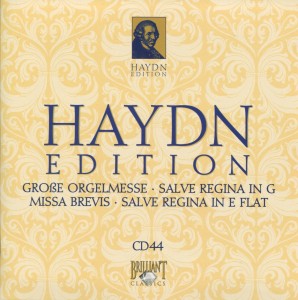 I can’t even pronounce the title of today’s CD.
I can’t even pronounce the title of today’s CD.
It’s a German word that uses a symbol (or a letter) I don’t recognize: Große.
After a bit of Googling, I discovered that the word means grosse, which means — I suppose — “great.” Orgelmesse is a compound word that means “organ mass.”
So, Große Orgelmesse in E Flat is the Great Organ Mass.
In E Flat.
Great.
Except it’s not.
Not to my ears, anyway.
It’s a mass, all right. With a bit of organ thrown in. But it all just sort of lies there. Nothing grabs me by the lapels and shakes me from my stupor.
Here. Listen for yourself:
Große Orgelmesse in E Flat Hob XXII:4 was composed in 1770. Haydn was 38.
Also on today’s CD are:
Salve Regina in G Hob XXIII:2
Salve Regina, according to Wiki,
The “Salve Regina”, also known as the Hail Holy Queen, is a Marian hymn and one of four Marian antiphons sung at different seasons within the Christian liturgical calendar of the Roman Catholic Church. The Salve Regina is traditionally sung at Compline in the time from the Saturday before Trinity Sunday until the Friday before the first Sunday of Advent. The Hail Holy Queen is also the final prayer of the Rosary.
And here it is:
Missa brevis in F Hob XXII:1.
This, I like — for two reasons:
1. It is said to be Haydn’s earliest authenticated work, composed when he was 17. According to its entry on Wikipedia,
Haydn re-encountered his mass in 1805. In the mean time he had experienced an illustrious career, but after about 1802 illness had reduced him to an invalid, unable to compose. The copy of the mass that was brought to his attention was in the Servite monastery in the Viennese suburb of Rossau. Haydn recognized the work as his own and wrote on the organ part, “di me Giuseppe Haydn mpri 1749” (“by me, Joseph Haydn, in my own hand 1749”).
Now that’s cool. Haydn, at the age of 73, rediscovers his own mass a half century after he composed it. If Haydn was, by that time, in ill health, unable to compose, it must have been a tremendously bittersweet moment to see something he created when he was just 17.
2. It is very, very simple, pleasant, and rudimentary. For that reason, it stands out. Plus, knowing what I now know about its origins, I see the mass in a new, more appreciative, light.
Unfortunately, I can’t find that anyone uploaded a YouTube clip of this composition.
Salve Regina in E flat Hob XXIII:46 is just more of the same.
Here it is:
I don’t know when it was composed.
All in all, today’s CD was a bit of a letdown after yesterday’s “big” mass. Others may dig these compositions. But I don’t find them to be Große.
